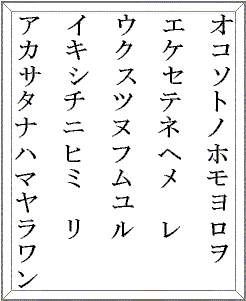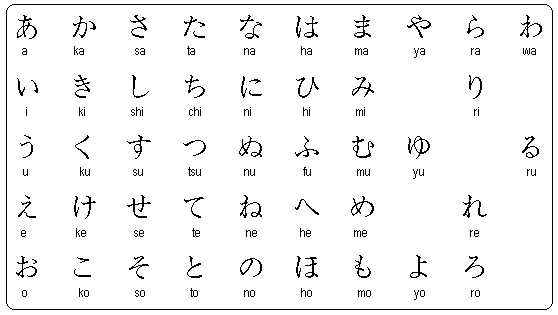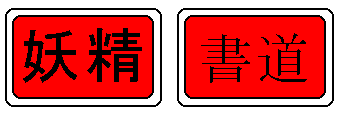"Greetings. My name is David. I am happy to meet you".
That's what it says above, though actually, it could be written right
to left, but nowadays it often follows the western style of left to right,
especially when the context is foreign loan words. If the context was solely
Japanese words, then traditionally, it would need to be up and down as well
as right to left. Also different characters would be used, but that will be
covered below. I have been fascinated with the Japanese, (Nihongo more
properly), language for some time, with it's sounds, and wonderfully written
letters. I find that the simple black and white Japanese characters are
often more beautiful than the best color painting. Their intrinsic ability,
stems as much from the blank spaces, as the brush strokes, and the lettering
is an art unto itself, that has a rich & lengthy history.
Firstly, I am in no way, a teacher, (sensei desu), or even Japanese.
I am a native Texan, and as a student of Japanese, simply wish to share my
fascination of it. For those of you with a better understanding of it than
myself, feel free to use the email on the main page, to inform me of my
mistakes, and I will correct them. For someone interested in a foreign
country, and/or it's language, the internet is a wonderful place to help
you learn, especially if you can't afford to go there and learn first hand.
): I have found so many great sites, (and barely scratched the surface I
am sure), and there are many more appearing all the time.
Japanese is a wonderful language, and not as hard to learn as one might think. Most words in Japanese do not have double and triple meanings, as in English, and the R's roll similar to those in Spanish, though once only, (or it is often referred to as a soft "D", as in the word, "Adam"), and the two share similar sounding vowels. Spain and Portugal were two of the first known western traders to Japan, in the 1600's, and began the assimilation of western words into the country. Partly because of this, Japan has two alphabets. "Hiragana", which is used for every day reading and writing, in proper Japanese. And "Katakana, which is used for foreign loan words borrowed from other countries, for street signs, marquis, and all kinds of advertisement, (and probably for a good deal more than I know). Two different alphabets might seem daunting at first. Yet though you have to memorized two sets of characters, there are basically only one set of phonetics, with only a couple of minor differences between them. So you really get 2 systems for one.
As far as the non phonetic kanji, (of which there are a couple of thousand in every day use in Nihon), they can be learned later, at your own pace, from a Kanji dictionary. However from what I have read of Kanji, Japanese school children are taught from a very early age, in repetitive drills in the class room. And this is probably the best way to learn them. Kanji is far older than the kana's, originally borrowed from China in the 6th century. The duel phonetic systems being devised from kanji later in the 900's, in an attempt to better fit the developing Japanese spoken word of the time, which differed too much from the non phonetic Chinese kanji, that had been used since then. At the time it was introduced to Japan, The Chinese had used kanji for over a thousand years, though it had changed many times, from simple drawings of the actual objects, to the more squared off linear images we see today. The Japanese kanji, may have also gone through changes, though I do not know as to how much different it is today, compared to it's inception. What little I know is that there are old, unused kanji, that the Japanese no longer use in their everyday lives.
I have heard the two schools of thought on which to study first, and most books I have read say that Hiragana should be first, it being the more important of the two used in everyday Japanese life, correspondence, legal letters, and the phonetic system of the spoken language. Katakana will undoubtedly be easier for most foreigners to pick up, since many of the loan-words are taken verbatim, from Spanish, Portuguese, English, Russian, and many other countries, with only mild differences in pronunciation from the original. English makes up the largest amount of loan words, and English speaking people, will immediately recognize thousands of words, once the characters are memorized.
I have found that for myself, the Hiragana alphabet is harder to memorize. Maybe it's because I can actually read Katakana, as I already know most of the words, or perhaps it's the squiggly lines of Hiragana that seem harder to memorize to me. I have had some great help lately, re learning both , with the aid of some awesome flash card & Japanese word processing programs I found free off the net. If you are studying Japanese, and want a Japanese word processor, I recommend Glenn Rosenthal's JWPCE. It's what I used to make most of the Japanese characters on my site. You can copy and paste it to paint or wherever you like. And it comes with an English/Japanese-Japanese/English dictionary. It is a wonderful program, and absolutely free. You can find it on Jim Breen's, "Monash Nihongo ftp" link below. Be prepared to spend some time there if you love Japanese on your computer. Lots to see and have for free, (thanks Jim and all). Also there are some great Japanese looking fonts on the net for your regular word processor, (see the links below for all of these mentioned here).
Katakana characters

Hiragana characters

<-Back to main page.
The Monash Nihongo ftp Archive
Japanese Flashcards
Japan Info Network
Golf Web, (Japan)
Japanese Online
Kyushu Central
hiragana times
Kyoto Book
FontEmpire
Nihon.com
